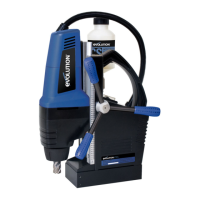4
www.evolutionsteel.com
TECHNICAL SPECIFICATION
Max Machine Height (mm): 670 (26-1/4”)
Min Machine Height (mm): 360 (14-1/8”)
Machine Width (mm): 180 (7”)
Machine Depth (mm): 300 (11-3/4”)
Machine Weight (Kg): 11.2 (25lbs)
RackStroke(mm): 130 (5-1/4”)
RatedMotorPower(Watts):
110 V/1200W (10A)
UK Voltage 1: 110V ~ 50/60Hz
UK Voltage 2: 230V ~ 50/60Hz
US Voltage 3: 120V ~ 50/60Hz
RatedCurrent(Amps)240V: 5.4
IPRating: 20
Spindle Speed –
No Load (min
-1
/rpm):
470
Number of Speeds: Single
PowerCordLength(Mtr/Yr): 2.1m (2-1/3yr)
InsulationClass: 1
MaxAnnularCuttingCapacity
(mm):
42 (1-5/8”)
MaxCuttingDepth(mm): 50 (2”)
StandardTwistDrillCapacity
(mm):
13 (1/”2)
Magnet Dimension (mm): 40 x 90 x 180
(1-3/4”x 3-3/4” x 7”)
Magnet Adhesion Stage 2
(Kg F):
1300 (2850 lbs)
Min Plate Thickness (mm): 10 (1/2”)
Sound Pressure Level L
PA
: 89.4dB(A) K=3dB(A)
Sound Power Level L
WA
: 102.4B(A) K=3dB(A)
Hand Arm Vibration a
n
: 0.629m/s
2
K=1.5m/
s
2
Note: The vibration measurement was made
under standard conditions in accordance
with BS EN 61029 – 1:2009.
VIBRATION
WARNING: When using this machine
the operator can be exposed to high
levels of vibration transmitted to the hand
and arm. It is possible that the operator could
develop “Vibration white finger disease”
(Raynaud syndrome). This condition can reduce
the sensitivity of the hand to temperature as
well as producing general numbness. Prolonged
or regular users of this machine should monitor
the condition of their hands and fingers closely.
If any of the symptoms become evident, seek
immediate medical advice.
• Themeasurementandassessmentofhuman
exposure to hand-transmitted vibration in
the workplace is given in: BS EN ISO 5349-
1:2001 and BS EN ISO 5349-2:2002
• Manyfactorscaninuencetheactualvibration
level during operation e.g. the work surfaces
condition and orientation and the type and
condition of the machine being used. Before
each use, such factors should be assessed, and
where possible appropriate working practices
adopted. Managing these factors can help
reduce the effects of vibration:
Handling
• Handlethemachinewithcare,allowingthe
machine to do the work.
• Avoidusingexcessivephysicaleffortonany
of the machines controls.
• Consideryoursecurityandstability,andthe
orientation of the machine during use.
Work Surface
• Considertheworksurfacematerial;
its condition, density, strength,
rigidity and orientation.
WARNING: The vibration emission during
actual use of the power tool can differ
from the declared total value depending on
the ways in which the tool is used. The need
to identify safety measures and to protect the
operator are based on an estimation of exposure
in the actual conditions of use (taking account of
all parts of the operating cycle, such as the times
the tool is switched off, when it is running idle,
in addition to trigger time).

